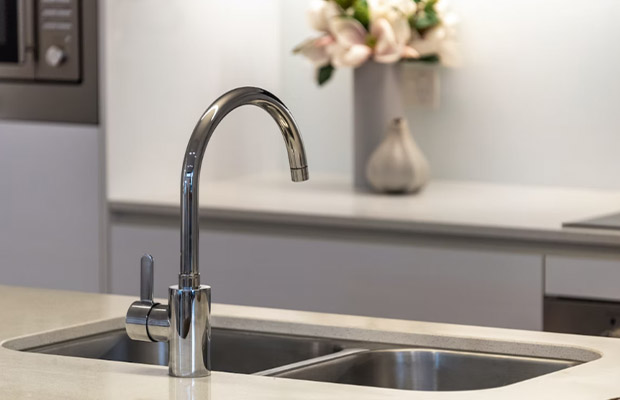An investment that will completely alter the design and usability of your kitchen is selecting a new kitchen sink. How to choose a kitchen sink?
You should consider several factors before making the purchase to ensure that you get the kitchen of your wildest dreams. Everything to consider before buying a sink is listed here, from the material to the ideal size to the critical decision between an under-mount or drop-in sink.
With this quick guide to the fundamentals, choosing the best kitchen sink has never been simpler, from drains to basins. Consider these hints for materials, configuration, and styles when choosing a kitchen sink. Let’s start!
Read More: Is It Safe To Drink Water Out Of The Kitchen Sink?
Table of Contents
Things To Consider Before Buying A Kitchen Sink
1. Think About The Source.
There are many materials available for kitchen sinks, including porcelain, stainless steel, and cast iron, to name a few. Be honest with yourself about how much use the sink will get and how often (and thoroughly) you plan to clean it. Porcelain sinks are prone to stains and scuff marks, but don’t worry—they can be removed! It only requires some hard work and a mildly abrasive cleaner like baking soda.
A stainless steel sink might be a wise purchase if you’re a little harder on your kitchen sink. They will be simpler to keep clean and have a very clean, contemporary look.
2. Pick An Undermount Or Drop-in.
What’s the distinction? A drop-in sink, as the name suggests, sinks into the counter, leaving a visible lip that rests on the counter. An undermount sink, in contrast, attaches below the counter and gives the appearance of being one piece.
Since the sink’s lip rests beneath the counter rather than on top, an undermount sink (like the stunning Elkay Lustertone Iconix Stainless Steel Sink) makes the most of the counter space. This sink is ideal for you if you value cleanliness in the kitchen: There is no lip between the sink and the edge of the countertop, so grime cannot accumulate there. Additionally, undermount sinks are regarded as a high-end option, so this chic kitchen sink could increase the value of your house if you ever decide to sell it.
The cost of a drop-in sink is typically lower, but cleaning it will take some attention. It’s your best option, though, if you must install the sink yourself.
3. Check To See If The Cabinets Need To Be Adjusted.
Consider cabinets as the base of your sink. If you’re not undertaking a complete renovation, you must carefully consider the style in light of what is already there. The main factor is: Verify that the depth and weight of the new sink can fit in the existing cabinets. For instance, a porcelain farmhouse sink filled with water can easily weigh over 100 pounds; the cabinetry needs to be able to support that weight.
4. Which Side Are You On, Single Or Double Bowl?
Have you ever encountered someone who thought their sink was too big? If you have enough room and funds, think about installing a double-bowl sink. It facilitates cleanup by allowing you to distinguish between dirty dishes and usable sink space. Additionally, it gives you more time before having to wash the dishes, which is ideal if you enjoy entertaining or have a large family that uses a lot of dishes every day.
If you’d rather have one large usable space without a divider in the middle, pick a large single bowl sink instead. If you frequently wash big serving utensils or pans, this is ideal for you. You’re sure to find a kitchen sink you’ll love if you start by considering how you cook and clean.
5. Pick The Appropriate Size.
When choosing a sink size, there are a few considerations you should make. Keep your budget in mind; typically, larger sinks cost more. Regarding how frequently you use the sink, you should also be honest with yourself. You can probably get away with a standard size (between 22 and 33 inches long) if you’re not a serious cook, but if you have the counter space, it’s always better to go bigger than smaller. Pay attention to the design’s scale as well. A sizable farmhouse-style sink runs the risk of overwhelming a small kitchen.

Kitchen Sink Installation Types
It is simpler to think of the appearance or style in terms of the installation type when choosing a new kitchen sink. It reduces the range of options and makes the procedure less daunting.
Drop-in Sinks
The simplest to install are kitchen sinks that drop into a countertop hole (also known as top-mount, self-rimming sinks) and are set into place. Drop-in sinks have a raised, rounded edge that helps keep water and debris inside the sink and sit on top of the counter cabinet.
Bar Sinks
Bar sinks or prep sinks are yet another unusual variety of sink. These installation types can be for farmhouse, drop-in, or undermount kitchen sinks, but due to their distinct functions, they stand out as their own installation type.
In addition to the kitchen sink, the bar sink is frequently used for drinks and entertaining rather than for the normal wear and tear of a sink full of dirty dishes that need to be soaked and washed. The prep sink is smaller than the kitchen sink, typically running narrower and shallower, and is most frequently found on the kitchen island or in a prep space like a wet bar or as a kitchenette sink.
Farmhouse Sinks
The deep, wide basins of the farmhouse kitchen sink, also known as apron-front sinks, are ideal for washing large pots and pans. To make a decorative panel out of the sink design itself, the front of the sink replaces the front edge of the countertop cabinetry. Farmhouse sinks come in different sizes and materials, and they add a dash of stylish country charm. For a more modern appearance, some models are also available in stainless steel.
Flush Mount Sink
These drop-in sinks are recessed into the counter just enough to be level with the countertop surface. They have a flat top and straight edge instead of a rounded lip, allowing it to be installed flush against the edge of the counter. Because they fit in with the countertop design, these are a popular style for kitchenette sinks as well.
Integrated Sinks
Sinks that are integrated into the countertop give the kitchen’s design a seamless appearance. The sink is molded from the same material as the solid countertop, creating a divot or pocket for the sink and blending in with the design of the rest of the counter.
Undermount Sinks
Workspace cleanup is simple with undermount sinks because they are attached beneath the countertop and create a flat surface. For a smooth transition from the countertop to the sink, the sink wall should be installed so that it sits up against the finished edge of the countertop.
Kitchen Sink Material
Metal and stone are just two of the many materials used to make kitchen sinks. The best kitchen sink material for you will depend on your budgetary constraints, preferred cleaning methods, and which material complements your kitchen’s design the best. A few typical choices to think about are listed below:
- Stainless-steel kitchen sinks are one of the most popular options and the material continues to be improved and upgraded. The thicker, less noisy 16- and 18-gauge sinks have replaced their cheaper predecessors. Numbers like 18/10 (18% chromium and 10% nickel) are used to identify the amount of chromium and nickel in stainless-steel sinks. In addition to adding corrosion resistance, the metal also adds a rich glow. Finishes range from a mirror-like shine to a satin luster. Because they are affordable, strong, and simple to maintain, stainless-steel kitchen sinks are popular. The less expensive sinks can occasionally make more noise when objects are dropped in, and they are more prone to getting scratched and developing water spots.
- Cast-iron kitchen sinks are made from a sturdy material that is enamel fired on an iron form. Although they can be heavy to install, these sturdy sinks reduce noise and vibration more than other materials. Cast-iron sinks come in a variety of colors, which is an added benefit.
- Composite sinks can be made of quartz, granite, or other materials mixed with acrylic- or polyester-resin base. They typically have a color that is speckled, are stain- and scratch-resistant, and are simple to maintain. They might, however, be pricey.
- Vitreous china, originally made for bathrooms, is now also used for kitchen sinks. While the sink material is brittle and prone to chipping, the glazed clay material is hard and nonporous with a glass-like shine. Because of the way it is made, vitreous china is less porous but is similar to fireclay in terms of construction, toughness, and price. Vulcanized china is easier to work with than fireclay when it comes to molding double bowl sinks.
- Solid surfacing, made from a polyester or acrylic base, is chosen for its stonelike appearance and easy care. Similar to countertops with solid surfaces, it is vulnerable to heat and nicks from sharp objects.
Kitchen Sink Faucets
Without a faucet, a kitchen sink isn’t much use, so when considering kitchen sink ideas, it’s important to think about what faucet features are important to you. The ideal kitchen sink faucet simplifies cleaning and cooking while also adding a stylish and useful fixture to the space. As you consider faucets, keep your preferences and routines in mind. Here are some quick suggestions for choosing a kitchen sink faucet:
- Finish: Optional decorative finishes to take into account include colors, easy-care brass, chrome, and others. It’s customary to match the metal finishes of kitchen appliances, but don’t be afraid to mix it up.
- Height: Look for designs that have detachable hose faucets, tall gooseneck faucets that can swivel out of the way, and traditional-looking faucets that appear to be flush but pull up for more height. Consider the style, depth, and finish of the sink, as well as the surrounding hardware, when planning for tasks like filling and cleaning tall stockpots.
- Spray: Do you favor using a sprayer that is independent of the faucet? If not, does the sprayer fit snugly into the faucet or is it so heavy that it might sag over time?
- Preferences: Which faucet features are most crucial? Do you prefer separate hot and cold controls or single handles, for instance? Keep in mind that many sinks come predrilled for handles and faucets, which will limit the types of faucets that will fit your sink.
- Comparison shop: To compare styles, installation techniques, faucets, and prices, visit a number of home improvement or plumbing supply stores.
- Maintenance: Think about the upkeep and lifespan of a sink. With proper care, faucets can last eight to twelve years on average. The simplest to keep clean are chrome faucets, which are most frequently found in kitchens.
Number Of Basins
Single, double, and triple basin kitchen sink configurations are available for kitchen sinks. You can find measurements for the basin split, which is the proportion of space occupied by each basin in a double bowl sink, as you browse the options. The two most popular configurations are 60/40, where one basin is larger to accommodate larger pots and pans, and 50/50, where the sink bowls are of equal size. Installing the garbage disposal in the smaller basin of a double basin sink so that the smaller side can be used as a prep sink is another typical kitchen sink configuration.
In some split basin sinks, the sides of the sink are different depths, while in others, interior racks may be present to help keep dishes out of the drain. Additionally, a variety of kitchen accessories are available to personalize your sink.
To aid you in deciding which basin configuration is best for your working style, here are a few benefits of each.
Single Basin Sink
- open space for soaking.
- Outstanding for large pots and pans.
- offers, in contrast to double or triple sinks, a basin that is typically much deeper.
- To help move liquids more quickly and keep the sink cleaner, the drains may be positioned off to one side, with the sink floor sloping to one side.
Double Basin Sink
- For performing separate tasks like washing and rinsing, double basin sinks are fantastic.
- One small and one large basin are both options, as are two basins of equal sizes.
- Basins can be angled to fit in countertop corners or have varying widths and lengths to create different shapes.
- To hold pots and pans, imagine one basin that is larger than the other.
Triple Basin Sinks
- Triple basin sinks typically occupy more countertop space than standard-sized sinks because they are wider.
- Depending on how you want your kitchen to look, try different configurations like pairing two large basins with a small basin, using three basins that are all the same size, or using three different-sized basins.
- Frequently used as a prep sink in the kitchen, the third basin is smaller.
Drain Placement Of Kitchen Sink
When deciding where to put the drain on your new sink, take into account the location of the existing plumbing and the type of work you do in the kitchen. The benefits (and drawbacks) of the various drain placement options are listed below.
Off-center Drain
Pros
- Off-center drains give you more room under the cabinet for taller supplies or filtration systems.
- Big pots and pans can be set down in the sink with plenty of room for water to drain.
- There is more space so you can prepare food without worrying about it falling into the drain.
Cons
- As the plumbing is pushed to the far back or corners of the under-sink cabinet, these can be challenging to repair.
Centered Drain
Pros
- Because there is a shorter distance for the water to travel, it drains more quickly than in an off-centered drain.
- improved accessibility under the sink for maintenance or repairs.
- aligns with a centered faucet.
Cons
- Large pots and pans might obstruct the flow of water to the drain.
Rear Drain
Pros
- An under-the-sink garbage disposal or even pullout shelves for trash and recycling cans would have plenty of room with rear drains.
- The water flow won’t be obstructed by dishes and pots in the sink.
- More room in the basin’s bottom for dishwashing or food preparation so that nothing falls down the drain while cleaning.
Cons
- These installations can be challenging, and because the plumbing is located behind the cabinet, maintenance is more difficult.
Additional Tips
- For convenience and accessibility, place the sink closer to the front edge of the counter.
- The amount of space under the sink that can be used for things like garbage disposals and filtered water systems depends on the depth of the basin and where the drain is located.
- Particularly in a corner location, make sure you have enough counter space on either side of the sink for food preparation.
Final Thoughts
It’s important to measure the kitchen sink’s size for reasons other than just ensuring that it will fit. Don’t forget to consider the sink’s primary function as well as the size of the countertop.
Please leave a comment below if you need help choosing a kitchen sink.
Related Reading:


